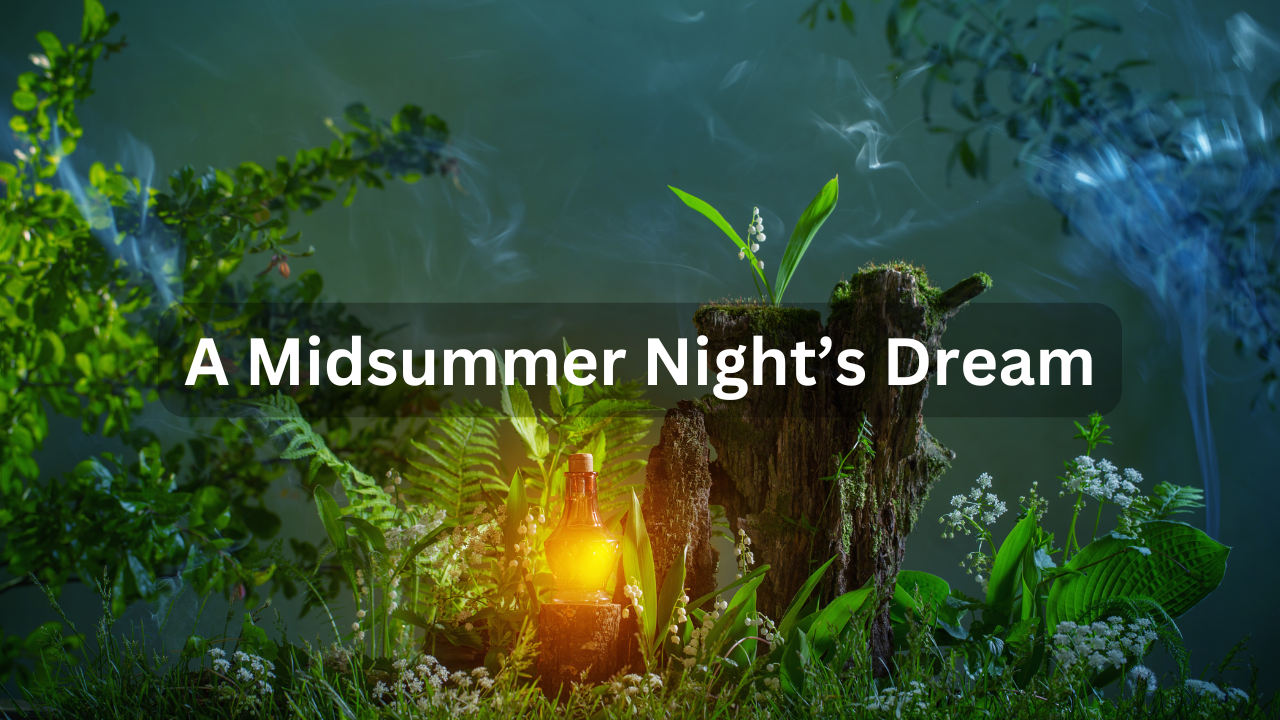When it comes to William Shakespeare, the man knew how to craft a good story. But if there’s one play where he truly let his imagination run wild, it’s A Midsummer Night’s Dream. Written around 1595-96, this romantic comedy is packed with magical forests, mischievous fairies, love triangles (or maybe squares?), and a play-within-a-play that’s so bad it’s hilarious.
This is Shakespeare’s most enchanting work, blending fantasy, humor, and just the right amount of chaos to make us fall in love with the Bard all over again. So, let’s break it down!
The Plot: Love, Fairies, and a Donkey-Headed Guy Walk Into a Forest
Here’s the scoop on what goes down in A Midsummer Night’s Dream:
Act 1: Love Gets Complicated
The play kicks off in Athens, where Duke Theseus is preparing for his wedding to Hippolyta. But the real drama starts with Hermia, who’s in love with Lysander. Unfortunately, her father wants her to marry Demetrius. Hermia refuses (you go, girl), but the Duke gives her an ultimatum: marry Demetrius, become a nun, or die. Yikes.
Hermia and Lysander decide to elope, running away into the forest. Meanwhile, Hermia’s BFF Helena—who’s hopelessly in love with Demetrius—spills the beans about the elopement to get in Demetrius’ good books. Spoiler: it doesn’t go as planned.
Act 2: Enter the Fairies
In the forest, we meet the magical crew: Oberon, the Fairy King, and Titania, his Queen, who are squabbling over custody of a little changeling boy. Oberon, being the petty king he is, orders his mischievous servant Puck to mess with Titania using a love potion from a magical flower.
But Oberon doesn’t stop there. He also wants to help Helena win Demetrius’ love, so he tells Puck to use the potion on Demetrius. Of course, Puck being Puck, messes it up and uses the potion on Lysander instead. When Lysander wakes up, he instantly falls in love with Helena, leaving Hermia heartbroken.
Now we’ve got two guys chasing Helena, Hermia chasing Lysander, and no one chasing Demetrius. Total chaos.
Act 3: A Donkey, a Love Potion, and a Lot of Confusion
Meanwhile, a group of Athenian tradesmen is rehearsing a play to perform at Theseus and Hippolyta’s wedding. Among them is Bottom, a weaver who’s so full of himself it’s almost endearing. Puck transforms Bottom’s head into that of a donkey (because why not?), and Titania—under the influence of the love potion—falls madly in love with him. Yes, a donkey.
As the mortals and fairies continue to stumble around the forest, Oberon realizes Puck’s love potion prank has gone too far. He orders Puck to fix the mess, which he does with a lot of magical flower juice and general fairy shenanigans.
Act 4: Love Restored
By morning, everything is back to normal—sort of. Titania wakes up horrified that she fell for a donkey, Oberon finally gets the changeling boy, and Puck removes the potion’s effects from Lysander, who returns to loving Hermia. Meanwhile, Demetrius (still under the spell) now loves Helena, which, honestly, works out great for everyone.
Act 5: Happily Ever After (Plus a Terrible Play)
The four lovers return to Athens, where Theseus pardons Hermia and approves the marriages of both couples. To celebrate, the tradesmen perform their play, “Pyramus and Thisbe.” It’s supposed to be tragic, but it’s so hilariously bad that the audience can’t stop laughing.
The play ends with Puck addressing the audience, asking us to think of the whole thing as a dream. Classic Shakespeare, leaving us wondering if we’ve been enchanted too.
Themes: What’s Shakespeare Really Saying?
1. The Foolishness of Love
Love makes people do dumb things—like chasing someone who doesn’t love you back or falling for a donkey. Shakespeare pokes fun at the absurdity of romance while still celebrating its magic.
2. Reality vs. Fantasy
The forest is a dreamlike world where the usual rules don’t apply. Shakespeare blurs the line between reality and fantasy, asking us to question how much of life is illusion.
3. The Power of Transformation
Whether it’s Bottom’s literal transformation into a donkey or the emotional transformations caused by the love potion, the play explores how people (and their feelings) can change in the blink of an eye—or with a sprinkle of fairy dust.
Why A Midsummer Night’s Dream Is Still Magical
Even centuries later, A Midsummer Night’s Dream remains one of Shakespeare’s most beloved plays. Here’s why:
- It’s hilarious. From Puck’s pranks to Bottom’s clueless confidence, the comedy still lands.
- It’s whimsical. Fairies, magic, and moonlit forests make the play feel like a storybook come to life.
- It’s relatable. Who hasn’t experienced the highs and lows of love—or felt like the butt of a cosmic joke?
Fun Facts About A Midsummer Night’s Dream
- It’s a crowd favorite: This play is one of the most performed Shakespeare works, loved for its humor and charm.
- The inspiration is a mystery: Scholars still debate what inspired Shakespeare to write this whimsical tale, but it’s likely a mix of folklore, Greek mythology, and pure imagination.
- It’s a play within a play: The tradesmen’s performance of “Pyramus and Thisbe” is an early example of meta-theater, poking fun at overly dramatic love stories.
Conclusion: A Comedy Worth Dreaming About
A Midsummer Night’s Dream is a perfect storm of Shakespearean brilliance—hilarious, enchanting, and deeply human. Whether you’re in it for the romantic chaos, the fairy mischief, or Bottom’s ridiculous antics, there’s something here for everyone.
As Puck so cheekily puts it: “Lord, what fools these mortals be!” And honestly, we wouldn’t have it any other way.

I’ll immediately seize your rss feed as I can not in finding your e-mail subscription link or newsletter service. Do you’ve any? Please allow me recognize so that I could subscribe. Thanks.